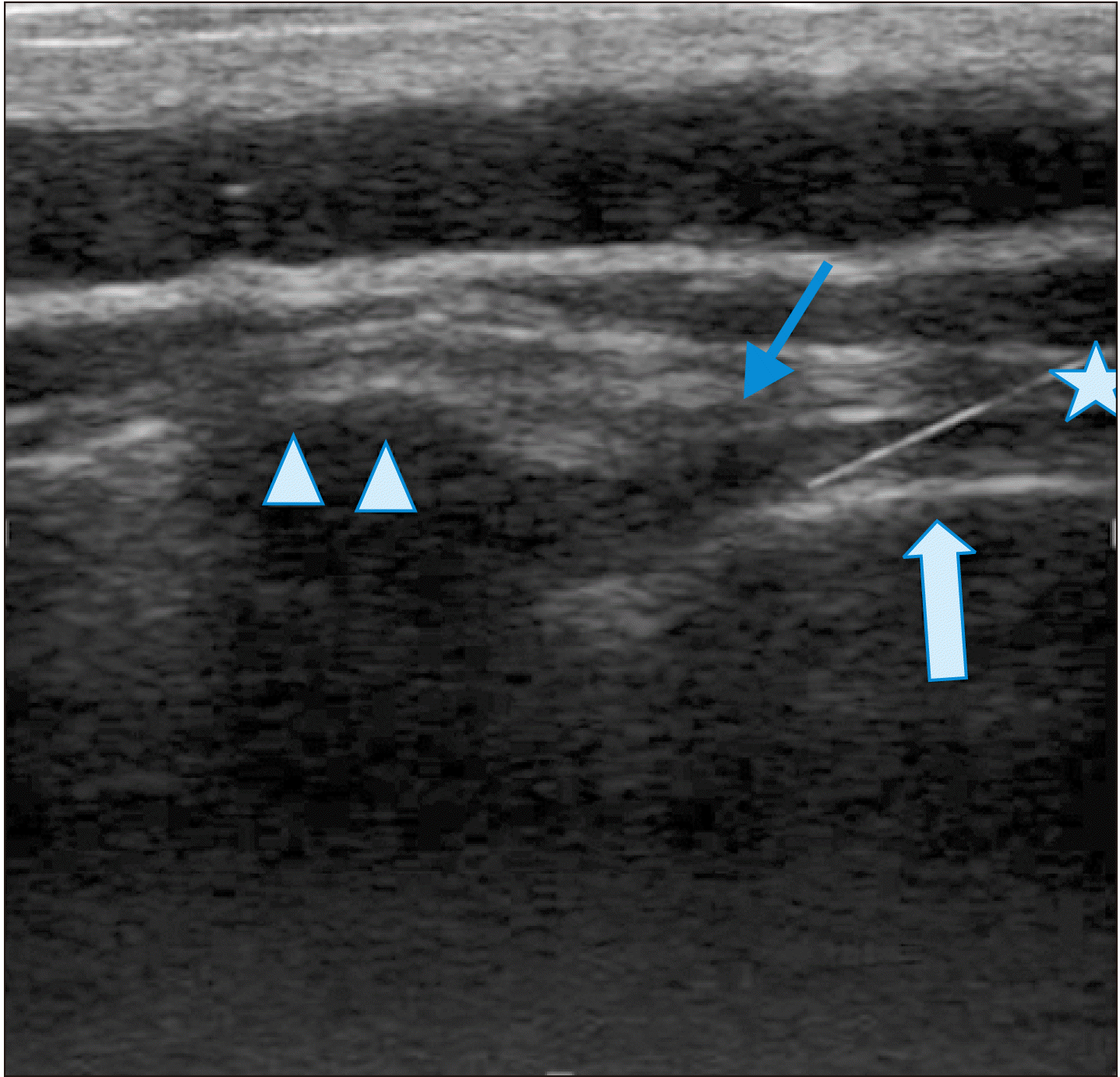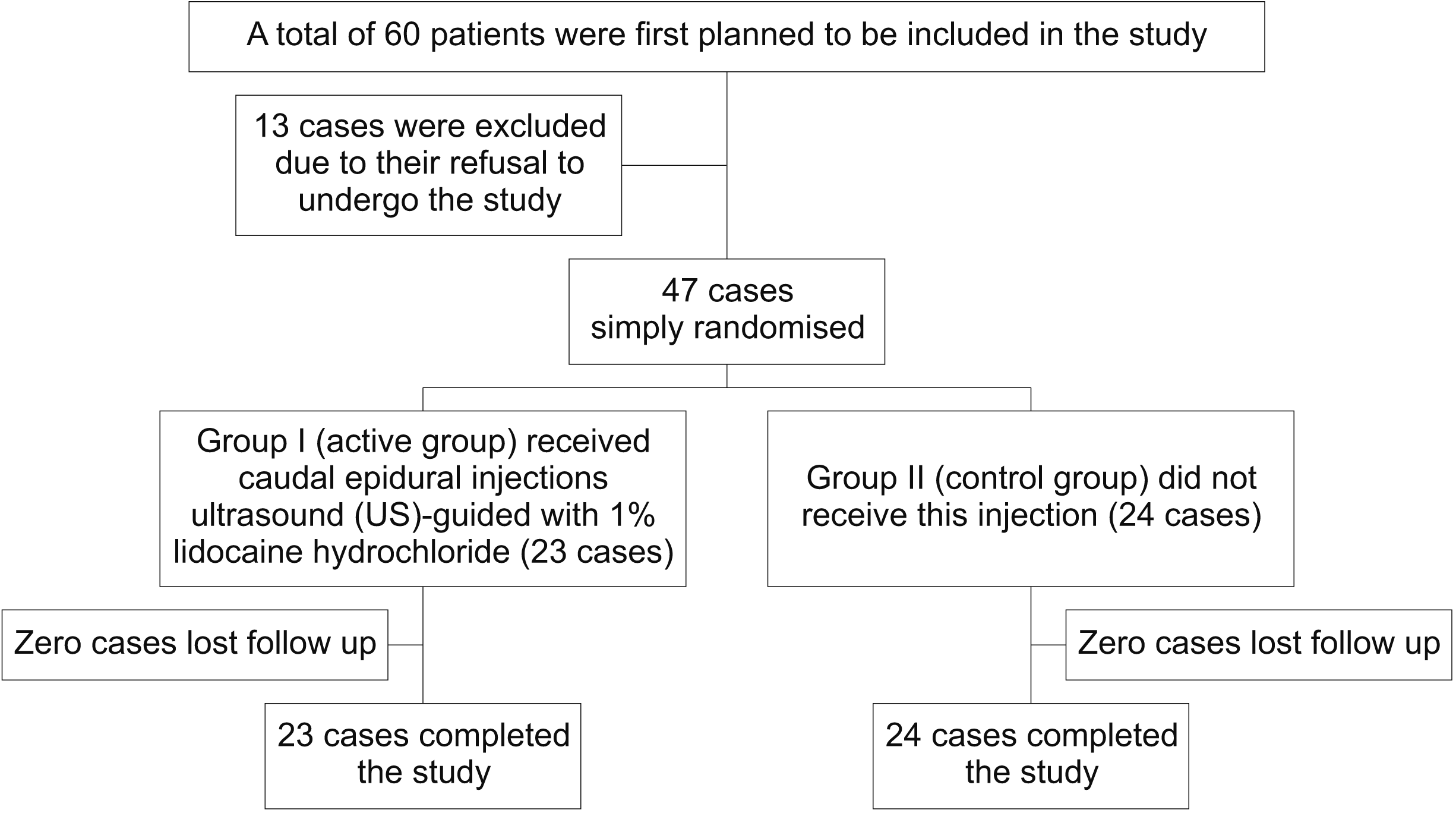1. Ward MM, Deodhar A, Gensler LS, Dubreuil M, Yu D, Khan MA, et al. 2019; 2019 update of the American College of Rheumatology/Spondylitis Association of America/Spondyloarthritis Research and Treatment Network recommendations for the treatment of ankylosing spondylitis and nonradiographic axial spondyloarthritis. Arthritis Rheumatol. 71:1599–613. DOI:
10.1002/art.41042. PMID:
31436036. PMCID:
PMC6764882.

2. Shahinyan A, Margaryan L, Samuel S. Abd-Elsayed A, editor. 2019. Ankylosing spondylitis. Pain: a review guide. Springer International Publishing;Cham: p. 1239–41. DOI:
10.1007/978-3-319-99124-5_265.

3. Antoni C, Braun J. 2002; Side effects of anti-TNF therapy: current knowledge. Clin Exp Rheumatol. 20(6 Suppl 28):S152–7. PMID:
12463468.
4. Walia AA, Tran H, DuBose D. Deer TR, Pope JE, Lamer TJ, Provenzano D, editors. 2019. Caudal epidural injection. Deer's treatment of pain: an illustrated guide for practitioners. Springer International Publishing;Cham: p. 455–60. DOI:
10.1007/978-3-030-12281-2_55.

5. Lee JJ, Nguyen ET, Harrison JR, Gribbin CK, Hurwitz NR, Cheng J, et al. 2019; Fluoroscopically guided caudal epidural steroid injections for axial low back pain associated with central disc protrusions: a prospective outcome study. Int Orthop. 43:1883–9. DOI:
10.1007/s00264-019-04350-w. PMID:
31168645.

7. Doo AR, Kim JW, Lee JH, Han YJ, Son JS. 2015; A comparison of two techniques for ultrasound-guided caudal injection: the influence of the depth of the inserted needle on caudal block. Korean J Pain. 28:122–8. DOI:
10.3344/kjp.2015.28.2.122. PMID:
25852834. PMCID:
PMC4387457.

8. Quack C, Schenk P, Laeubli T, Spillmann S, Hodler J, Michel BA, et al. 2007; Do MRI findings correlate with mobility tests? An explorative analysis of the test validity with regard to structure. Eur Spine J. 16:803–12. DOI:
10.1007/s00586-006-0264-z. PMID:
17143634. PMCID:
PMC2200719.

9. Machado PM, Landewé R, Heijde DV. Assessment of SpondyloArthritis international Society (ASAS). 2018; Ankylosing Spondylitis Disease Activity Score (ASDAS): 2018 update of the nomenclature for disease activity states. Ann Rheum Dis. 77:1539–40. DOI:
10.1136/annrheumdis-2018-213184. PMID:
29453216.

10. Assassi S, Weisman MH, Lee M, Savage L, Diekman L, Graham TA, et al. 2014; New population-based reference values for spinal mobility measures based on the 2009-2010 National Health and Nutrition Examination Survey. Arthritis Rheumatol. 66:2628–37. DOI:
10.1002/art.38692. PMID:
24782356. PMCID:
PMC4146670.

11. Haywood KL, Garratt AM, Jordan K, Dziedzic K, Dawes PT. 2004; Spinal mobility in ankylosing spondylitis: reliability, validity and responsiveness. Rheumatology (Oxford). 43:750–7. DOI:
10.1093/rheumatology/keh169. PMID:
15163832.

12. Elsaman AM, Radwan AR, Mohammed WI, Ohrndorf S. 2016; Low-dose spironolactone: treatment for osteoarthritis-related knee effusion. A prospective clinical and sonographic-based study. J Rheumatol. 43:1114–20. DOI:
10.3899/jrheum.151200. PMID:
27036390.

13. Carlsson AM. 1983; Assessment of chronic pain. I. Aspects of the reliability and validity of the visual analogue scale. Pain. 16:87–101. DOI:
10.1016/0304-3959(83)90088-X. PMID:
6602967.

15. Khan MA, van der Linden S. 2019; Axial spondyloarthritis: a better name for an old disease: a step toward uniform reporting. ACR Open Rheumatol. 1:336–9. DOI:
10.1002/acr2.11044. PMID:
31777810. PMCID:
PMC6857996.

16. Zochling J. 2011; Measures of symptoms and disease status in ankylosing spondylitis: Ankylosing Spondylitis Disease Activity Score (ASDAS), Ankylosing Spondylitis Quality of Life Scale (ASQoL), Bath Ankylosing Spondylitis Disease Activity Index (BASDAI), Bath Ankylosing Spondylitis Functional Index (BASFI), Bath Ankylosing Spondylitis Global Score (BAS-G), Bath Ankylosing Spondylitis Metrology Index (BASMI), Dougados Functional Index (DFI), and Health Assessment Questionnaire for the Spondylarthropathies (HAQ-S). Arthritis Care Res (Hoboken). 63 Suppl 11:S47–58. DOI:
10.1002/acr.20575. PMID:
22588768.
17. van der Heijde D, Landewé R, Feldtkeller E. 2008; Proposal of a linear definition of the Bath Ankylosing Spondylitis Metrology Index (BASMI) and comparison with the 2-step and 10-step definitions. Ann Rheum Dis. 67:489–93. DOI:
10.1136/ard.2007.074724. PMID:
17728332.

18. Hawker GA, Mian S, Kendzerska T, French M. 2011; Measures of adult pain: Visual Analog Scale for Pain (VAS Pain), Numeric Rating Scale for Pain (NRS Pain), McGill Pain Questionnaire (MPQ), Short-Form McGill Pain Questionnaire (SF-MPQ), Chronic Pain Grade Scale (CPGS), Short Form-36 Bodily Pain Scale (SF-36 BPS), and Measure of Intermittent and Constant Osteoarthritis Pain (ICOAP). Arthritis Care Res (Hoboken). 63 Suppl 11:S240–52. DOI:
10.1002/acr.20543. PMID:
22588748.
19. O'Shea FD, Riarh R, Anton A, Inman RD. 2010; Assessing back pain: does the Oswestry Disability Questionnaire accurately measure function in ankylosing spondylitis? J Rheumatol. 37:1211–3. DOI:
10.3899/jrheum.091240. PMID:
20395642.
20. Apáthy A, Penczner G, Licker E, Eiben A, Bálint G, Genti G, et al. 1999; [Caudal epidural injection in the management of lumbosacral nerve pain syndromes]. Orv Hetil. 140:1055–8. Hungarian. PMID:
10339997.
21. Stewart GJ, Knight LC, Arbogast BW, Stern HS. 1980; Inhibition of leukocyte locomotion by tocainide, a primary amine analog of lidocaine: at study with 111indium-labeled leukocytes and scanning electron microscopy. Lab Invest. 42:302–9. PMID:
6767137.
22. Cassuto J, Sinclair R, Bonderovic M. 2006; Anti-inflammatory properties of local anesthetics and their present and potential clinical implications. Acta Anaesthesiol Scand. 50:265–82. DOI:
10.1111/j.1399-6576.2006.00936.x. PMID:
16480459.

23. Hogan QH, Stadnicka A, Bosnjak ZJ, Kampine JP. 1998; Effects of lidocaine and bupivacaine on isolated rabbit mesenteric capacitance veins. Reg Anesth Pain Med. 23:409–17. DOI:
10.1097/00115550-199823040-00017. PMID:
9690595.

24. Reyes-García MG, García-Tamayo F. 2009; A neurotransmitter system that regulates macrophage pro-inflammatory functions. J Neuroimmunol. 216:20–31. DOI:
10.1016/j.jneuroim.2009.06.024. PMID:
19732963.

25. Manchikanti L, Cash KA, McManus CD, Pampati V, Fellows B. 2012; Fluoroscopic caudal epidural injections with or without steroids in managing pain of lumbar spinal stenosis: one-year results of randomized, double-blind, active-controlled trial. J Spinal Disord Tech. 25:226–34. DOI:
10.1097/BSD.0b013e3182160068. PMID:
22652990.
26. Stav A, Ovadia L, Sternberg A, Alfici R, Landau M. 1994; Cervical and lumbar epidural steroid injections for pain relief in patients with Bechterew's syndrome. Preliminary results. Pain Clin. 7:283–9.
27. Lee SW, Song Y, Lee S, Joo KB, Sung IH, Kim TH. 2015; AB0755 An intraarticular sacroiliac corticosteroid injections in ankylosing spondylitis. Ann Rheum Dis. 74 Suppl 2:1151. DOI:
10.1136/annrheumdis-2015-eular.3778.
28. Eriksson AS, Sinclair R, Cassuto J, Thomsen P. 1992; Influence of lidocaine on leukocyte function in the surgical wound. Anesthesiology. 77:74–8. DOI:
10.1097/00000542-199207000-00011. PMID:
1610012.

29. Björck S, Dahlström A, Ahlman H. 1989; Topical treatment of ulcerative proctitis with lidocaine. Scand J Gastroenterol. 24:1061–72. DOI:
10.3109/00365528909089256. PMID:
2595267.

30. Jönsson A, Brofeldt BT, Nellgård P, Tarnow P, Cassuto J. 1998; Local anesthetics improve dermal perfusion after burn injury. J Burn Care Rehabil. 19(1 Pt 1):50–6. DOI:
10.1097/00004630-199801000-00011. PMID:
9502024.

31. Gungor S, Aiyer R, Erkan D. 2018; Cervical epidural injection in the management of refractory pain and stiffness in spondyloarthropathy: a case report series. Pain Pract. 18:532–8. DOI:
10.1111/papr.12616. PMID:
28742241.

32. Manchikanti L, Singh V, Cash KA, Pampati V, Datta S. 2010; Management of pain of post lumbar surgery syndrome: one-year results of a randomized, double-blind, active controlled trial of fluoroscopic caudal epidural injections. Pain Physician. 13:509–21. PMID:
21102963.
33. Parr AT, Manchikanti L, Hameed H, Conn A, Manchikanti KN, Benyamin RM, et al. 2012; Caudal epidural injections in the management of chronic low back pain: a systematic appraisal of the literature. Pain Physician. 15:E159–98. PMID:
22622911.
34. Monti S, Todoerti M, Codullo V, Favalli EG, Biggioggero M, Becciolini A, et al. 2018; Prevalence of Ankylosing Spondylitis Disease Activity Score (ASDAS) inactive disease in a cohort of patients treated with TNF-alpha inhibitors. Mod Rheumatol. 28:542–9. DOI:
10.1080/14397595.2017.1367076. PMID:
28880727.

35. Lubrano E, Perrotta FM, Manara M, D'Angelo S, Ramonda R, Punzi L, et al. 2020; Improvement of function and its determinants in a group of axial spondyloarthritis patients treated with TNF inhibitors: a real-life study. Rheumatol Ther. 7:301–10. DOI:
10.1007/s40744-020-00197-5. PMID:
32062827. PMCID:
PMC7211226.

36. Amor B, Dougados M, Listrat V, Menkes CJ, Roux H, Benhamou C, et al. 1995; Are classification criteria for spondylarthropathy useful as diagnostic criteria? Rev Rhum Engl Ed. 62:10–5. PMID:
7788318.
37. van der Heijde D, Baraf HS, Ramos-Remus C, Calin A, Weaver AL, Schiff M, et al. 2005; Evaluation of the efficacy of etoricoxib in ankylosing spondylitis: results of a fifty-two-week, randomized, controlled study. Arthritis Rheum. 52:1205–15. DOI:
10.1002/art.20985. PMID:
15818702.

38. Sieper J, Lenaerts J, Wollenhaupt J, Rudwaleit M, Mazurov VI, Myasoutova L, et al. 2014; Efficacy and safety of infliximab plus naproxen versus naproxen alone in patients with early, active axial spondyloarthritis: results from the double-blind, placebo-controlled INFAST study, Part 1. Ann Rheum Dis. 73:101–7. DOI:
10.1136/annrheumdis-2012-203201. PMID:
23696633. PMCID:
PMC3888606.

39. van der Heijde D, Dijkmans B, Geusens P, Sieper J, DeWoody K, Williamson P, et al. 2005; Efficacy and safety of infliximab in patients with ankylosing spondylitis: results of a randomized, placebo-controlled trial (ASSERT). Arthritis Rheum. 52:582–91. DOI:
10.1002/art.20852. PMID:
15692973.

40. van der Heijde D, Kivitz A, Schiff MH, Sieper J, Dijkmans BA, Braun J, et al. 2006; Efficacy and safety of adalimumab in patients with ankylosing spondylitis: results of a multicenter, randomized, double-blind, placebo-controlled trial. Arthritis Rheum. 54:2136–46. DOI:
10.1002/art.21913. PMID:
16802350.

41. Inman RD, Davis JC Jr, Heijde Dv, Diekman L, Sieper J, Kim SI, et al. 2008; Efficacy and safety of golimumab in patients with ankylosing spondylitis: results of a randomized, double-blind, placebo-controlled, phase III trial. Arthritis Rheum. 58:3402–12. DOI:
10.1002/art.23969. PMID:
18975305.

42. Poddubnyy D, Gensler LS. 2014; Spontaneous, drug-induced, and drug-free remission in peripheral and axial spondyloarthritis. Best Pract Res Clin Rheumatol. 28:807–18. DOI:
10.1016/j.berh.2014.10.005. PMID:
25488786. PMCID:
PMC4289210.

43. Braun J, Yu DTY. Stone JH, editor. 2009. Ankylosing spondylitis. A clinician's pearls and myths in rheumatology. Springer;London: p. 57–65. DOI:
10.1007/978-1-84800-934-9_7.

44. Badsha H, Tak PP. 2008; Can Islamic prayers benefit spondyloarthritides? Case report of a patient with ankylosing spondylitis and increased spinal mobility after an intensive regimen of Islamic prayer. Rheumatol Int. 28:1057–9. DOI:
10.1007/s00296-008-0557-0. PMID:
18324379.

45. Renson T, Depicker A, De Craemer AS, Deroo L, Varkas G, de Hooge M, et al. 2020; High prevalence of spondyloarthritis-like MRI lesions in postpartum women: a prospective analysis in relation to maternal, child and birth characteristics. Ann Rheum Dis. 79:929–34. DOI:
10.1136/annrheumdis-2020-217095. PMID:
32299794.

46. Murakibhavi VG, Khemka AG. 2011; Caudal epidural steroid injection: a randomized controlled trial. Evid Based Spine Care J. 2:19–26. DOI:
10.1055/s-0031-1274753. PMID:
23230402. PMCID:
PMC3506149.

47. Prost S, Farah K, Mazas S, Pesenti S, Fuentes S, Tropiano P, et al. 2020; Sacral hiatus corticosteroid injection in the management of radicular pain in adults. Orthop Traumatol Surg Res. 106:1191–3. DOI:
10.1016/j.otsr.2020.05.011. PMID:
32917581.

48. Iqbal MR, Ali L, Shah SHA, Iqbal M, Waseem SM, Hamid S. 2020; Comparison of analgesic efficacy of transforaminal vs caudal epidural approaches for unilateral lumbar radiculopathy. Pak Armed Forces Med J. 70 Suppl 1:S135–39.





 PDF
PDF Citation
Citation Print
Print




 XML Download
XML Download